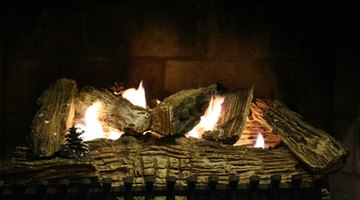Is Willow Tree Wood Good for Burning?
When it comes to selecting firewood, wood that comes from willow trees is among the least desirable of all firewoods. Willow produces a low amount of heat and burns very quickly compared to oak or maple firewood. Using willow in a stove can lead to a buildup of creosote in the stove pipe that can cause a chimney fire.

BTU Explained
All firewoods are ranked by the BTU system. BTU stands for British Thermal Unit, the amount of heat that a given amount of firewood will produce over a given amount of time. The BTU rating is typically assigned to firewood based on the amount of heat produced by burning a cord of wood. A cord is a stack of wood that is 4 feet deep by 8 feet wide and 4 feet high. Willow produces a BTU rating of approximately 17.5 to 18.6. By contrast, firewood made from live oaks produces a BTU rating of 34.4 to 36.6.
Softwoods vs. Hardwoods
In general, all softwoods including willow, aspen, firs and pine do not have a high BTU rating because the wood fibers in these woods are not very dense. The space between the wood fibers are often filled with sap or other moisture. Firewood from these types of wood do not burn very well at all when green. The wood often takes as long as two years to season properly. Once the wood is seasoned, it is dry and filled with air and will burn almost like paper: very quickly in a fire that is very hot and will not create coals. By contrast, hard woods have very little space between the fibers of the wood. The hardwood will season in less than a year and will burn slowly in a fire that creates coals and gives off much heat.
How Wood Burns
Burning wood is a process of chemical reaction. Any moisture left in the wood evaporates. Additionally, the wood breaks down chemically into charcoal, gas and volatile liquids. As charcoal burns, it forms carbon dioxide. When softwoods such as willow burn, they primarily convert to gasses such as creosote. These gasses escape up the chimney, taking most of the heat with them. In the chimney, substances such as creosote condense. Chimneys in which softwoods burn must be cleaned more often. If the chimney is not cleaned, the buildup of soot and creosote can catch on fire.
True Wood Value
Because willow wood has a low BTU rating, it is also low value fuel to burn. The value of fuel may be calculated by multiplying the BTU of the fuel by the efficiency rating of the method used to heat and dividing this by the cost of the fuel. For example, if you purchase a cord of willow wood for $40 and burn it in a fireplace that is 50 percent efficient, the equation would look like this: (17.6 x .50) / $40.00 = $4.54 per million BTU. By comparison, a cord of live oak factored into the same equation would cost $2.32 per million BTU.
References
Resources
Writer Bio
Tracy Morris has been a freelance writer since 2000. She has published novels and numerous online articles. Her work has appeared in national magazines and newspapers including "Ferrets," "CatFancy," "Lexington Herald Leader" and "The Tulsa World." She holds a Bachelor of Arts in journalism from the University of Arkansas.
Photo Credits
- fireplace image by Ekaterina Sidorenko from Fotolia.com
- fireplace image by Ekaterina Sidorenko from Fotolia.com
More Articles



